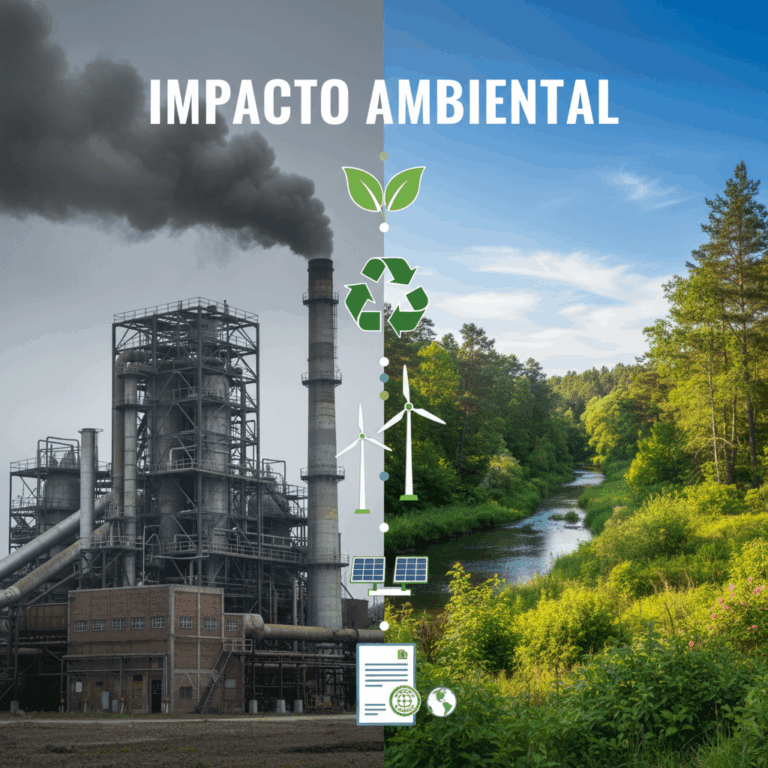Industrial emissions and their environmental impact
The industrial emissions They are a major source of environmental pollution. These emissions include gases and particles that affect multiple ecosystems.
The environmental impact caused by these emissions is reflected in the air, soil and water qualitycausing a deterioration that affects public health and biodiversity.
Industry, especially in sectors such as energy and manufacturing, contributes significantly to the increase in greenhouse gases and toxic pollutants.
Main polluting gases and affected sectors
The main polluting gases include carbon dioxide (CO2), methane (CH4) and nitrogen oxides (NOx), linked to global warming and air pollution.
The affected sectors are mainly energy, metallurgy and manufacturing, which use fossil fuels and intensive industrial processes.
These sectors emit high volumes of polluting gases, generating a negative impact on the environment and contributing to climate change.
Managing these emissions is critical to addressing global sustainability challenges and protecting natural resources.
Effects on air, soil and water quality
Industrial emissions deteriorate the quality of airincreasing the presence of pollutants that cause respiratory illnesses and atmospheric acidification.
The soil becomes contaminated with toxic waste that affects fertility and microbial life, compromising agricultural production and local ecosystems.
Furthermore, the pollution of water Industrial spills alter the chemical and biological composition, harming wildlife and the water supply.
These combined effects require urgent action to mitigate the environmental consequences and protect human health.
Environmental regulations in the industry
The environmental regulations In industry, these regulations are vital for controlling emissions of polluting gases and mitigating their impact. They aim to balance production and environmental protection.
In different regions, legislation establishes specific limits and tools to monitor and reduce industrial emissions, promoting more sustainable practices.
Compliance with these regulations is essential to address climate change and improve the quality of life, both locally and globally.
European regulations and emissions trading systems
The European Union applies strict directives that regulate industrial emissions in thousands of facilities, focusing on reducing greenhouse gases.
He emissions trading system It covers approximately 45% of European emissions, incentivizing companies to reduce their pollutants through tradable limits and permits.
This strategy promotes innovation and energy efficiency, facilitating a market that rewards voluntary emissions reductions.
In this way, the EU is moving towards a low-carbon economy with clear targets for 2030 and beyond.
Regulations in the United States and compliance with goals
In the United States, regulations such as GEMM 2 mandate a 20 % reduction in emissions by 2030, based on 2015 levels.
These regulations include the obligation to submit reduction plans evaluated by independent entities, ensuring transparency and effectiveness.
The regulations are focused on key sectors such as energy and manufacturing, leveraging clean technologies and sustainable practices to meet the goals.
Strict compliance is essential to align with international commitments and protect public health.
Campaigns and technologies for emissions reduction
Global campaigns, such as the International Day for Reducing CO2 Emissions, promote awareness of the importance of reducing industrial pollutants.
Governments and companies are investing in advanced filtration and control technologies to minimize harmful emissions in sectors such as mining, cement, and energy.
These innovations enable a cleaner and more efficient industry, contributing to environmental improvement and the mitigation of climate change.
Challenges and consequences of industrial pollution
The industrial pollution It poses significant challenges to public health and global environmental sustainability. The negative effects can be devastating if left unchecked.
It is essential to address both the current consequences and the technological and social challenges in order to achieve an effective reduction in emissions and protect communities.
Many countries face the pressure of balancing economic growth with strict environmental policies that reduce the polluting footprint of industry.
Impact on public health and number of deaths
Air pollution from industry contributes to millions of premature deaths annually worldwide, primarily affecting children and vulnerable people.
Respiratory diseases, cardiovascular diseases and cancer are related to exposure to toxic gases and particles released during industrial processes.
Health systems face increased costs and burdens due to the rise in pollution-related illnesses, underscoring the urgency of effective policies.
Reducing these emissions is key to improving the quality of life and decreasing mortality associated with industrial pollution.
Technological and social challenges to minimize pollution
The development of clean technologies and efficient processes is fundamental to reducing polluting emissions without sacrificing industrial productivity.
However, the implementation of these technologies faces economic and infrastructure challenges, especially in developing regions.
Socially, it is vital to foster awareness and community participation to drive change and adopt sustainable practices at all levels.
Innovation and citizen participation as key elements
Technological innovation must be accompanied by policies that encourage its adoption, as well as environmental education to create an active and responsible citizenry.
Only with an integrated approach that combines scientific advances and social commitment will it be possible to effectively minimize the industrial environmental impact.
Sustainable practices and environmental responsibility
The adoption of sustainable practices It is crucial for the industry to reduce its environmental impact and promote more planet-friendly production.
Companies are integrating ESG agendas that combine environmental, social, and governance criteria to achieve a energy efficiency real and sustainable.
These strategies seek to balance economic growth with environmental protection, promoting the use of renewable energy and significantly reducing waste.
Implementation of ESG agendas and energy efficiency
The ESG agendas They are key tools for industries to integrate sustainability into their operations and reduce their ecological footprint.
These agendas prioritize the energy efficiency through the modernization of processes and the adoption of clean technologies that optimize resource consumption.
Many companies are investing in innovations that allow for lower emissions, greater recycling, and responsible management of industrial waste.
Furthermore, transparency and progress reporting foster investor and consumer confidence, reinforcing corporate commitment to the environment.
International commitments and court rulings
The international commitments They demand that countries and industries reduce emissions to curb climate change and protect global ecosystems.
Agreements such as the Paris Agreement encourage the development of national policies that promote environmental responsibility and the transition to clean energy.
Recently, court rulings, such as that of the International Court of Justice, have underlined the legal obligation of States to act to reduce their polluting emissions.
These resolutions strengthen the pressure on industries and governments, promoting a legal framework that guarantees compliance with climate and environmental goals.







